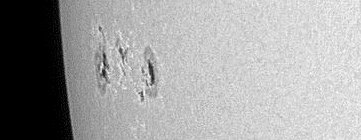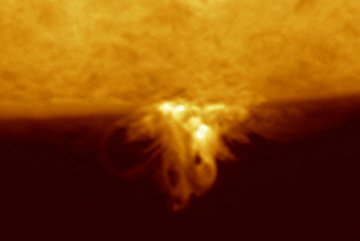 Where's Saturn? Is that a UFO--or the ISS? What's the name of that star? Get the answers from mySKY--a fun new astronomy helper from Meade. Where's Saturn? Is that a UFO--or the ISS? What's the name of that star? Get the answers from mySKY--a fun new astronomy helper from Meade. MARS UPDATE: A late-June dust storm that delayed Mars rover Opportunity's descent into Victoria Crater has intensified and spread around the planet, reports veteran observer Jim Melka of St. Louis, Missouri. On July 6th, the view through Melkin's 12-inch telescope showed "a chain of five dust clouds over Mare Cimmerium," he says. "One cloud is very close to the location of the Opportunity's twin, Spirit." Stay tuned for updates. NEW SUNSPOT: New sunspot 963 has just emerged over the sun's eastern limb, and "it's a grand sight," says Howard Eskildsen who took this picture from his backyard in Ocala, Florida: 
Photo details: Meade ETX-125, Astrosolar Photoflim,Orion StarShoot II
The sunspot's two dark cores are each larger than Earth, and they are connected by an unstable magnetic field that crackles with C-class solar flares. The eruptions have been entertaining onlookers with solar telescopes. "I watched in amazement for hours as the magnetic loops swayed back and forth," says Larry Alvarez of Flower Mound, Texas. Using a Coronado SolarMax90, he made a movie of the action. Click on the snapshot to watch: 
See the movie: Small (600 kb gif) or Large (6 MB avi)
Meanwhile in Zanesville, Ohio, this sunspot almost made artist Erika Rix late for her brother's wedding. "I just couldn't tear my eyes away from the eyepiece," she explains. "The erupting prominence sequence reminded me of a rock plopping in the water. It was brilliant to watch." Using Strathmore paper and white Conte' crayon, Erika sketched what she saw: image. "As a last minute idea to add to their wedding present, I framed the first sketch of this sequence with the date for them....starting their new lives together with a bang." more images: from Pavol Rapavy of Rimavska Sobota, Slovakia; from Michael Borman of Evansville, Indiana; from Joel Bavais of Ath, Belgium; from John C McConnell of Maghaberry Northern Ireland; from Peter Paice of Belfast, Northern Ireland; from Wee Nghee of Singapore; from Britta Suhre of Dortmund, Germany; from Jean-Marc Lecleire of Torcy, France; from John Stetson of South Portland, Maine.
2007 Noctilucent Cloud Gallery
["Noctilucent Cloud"--the song] [Night-Sky Cameras] | 
